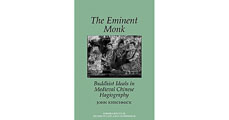start > Klassieke teksten > Late Han tot Tang > tekst
高僧傳 Gaoseng zhuan
Engelse titel: Biographies of eminent monks
The Gaoseng zhuan (Biographies of eminent monks), compiled by Shi Huijiao 釋慧皎 (497-554), is the primary source for information about monks in China from the beginnings of Chinese Buddhism in the first century until the book's completion in approximately 530. A number of collections of monks' biographies had appeared before the Gaoseng zhuan, but, with the exception of a few fragments, these are not extant. The Gaoseng zhuan can be mined for historical data about key figures, doctrines, monasteries, and events. Drawing on a wide variety of sources, the text further reflects generally held beliefs and perceptions of Buddhism and monks in the sixth century, including, for instance, conceptions of the spirit world and criteria for evaluating what was to be considered an "eminent" monk.
The influence of the Gaoseng zhuan extends well beyond the date of its composition. From the early sixth century on, the Gaoseng zhuan was avidly read and quoted by monks, laymen and even those with no Buddhist affiliation. The Gaoseng zhuan is also important in the development of Buddhist historiography in China. Regarding the criteria for inclusion, the organization of biographies, and the inclusion of commentaries by the historian, the Gaoseng zhuan served as the model for two later major collections of biographies of monks, the Xu Gaoseng zhuan, q.v., compiled by Daoxuan 道宣 in the seventh century, and the Song Gaoseng zhuan 高僧傳, compiled by Zanning 贊寧 at the end of the tenth. Although the style and principles of compilation of monastic biography subsequently underwent radical changes, the Gaoseng zhuan remained the most popular and admired collection of monastic biographies in Chinese Buddhist history.
The Gaoseng zhuan contains 257 major biographies. More than 200 subordinate biographies of figures Huijiao considered of lesser importance are attached to major biographies (there is divergence of opinion on how many subordinate biographies there because subordinate biographies,fuzhuan 附傳, were not marked off as such by Huijiao). The earliest account purports to describe events of a.d. 67, the last from 519. The biographies are divided into ten categories (zie tab hoofdstukken). At the end of each section, Huijiao appended a disquisition (lun 論) in which he discusses the theme of the section.
Although Huijiao’s authorship of the text is undisputed, we know very little about him. Other than the detail that he was a native of Kuaiji 會稽, we know nothing of Huijiao's early life or even his secular surname. As a monk he lived at a monastery in Kuaiji where he was said to have composed commentaries to the Nirvana Sutra and to the Fanwangjing 梵網經,an indigenous scripture on the monastic regulations. These works are not extant. Soon after Kuaiji's fall to Hou Jing 候景 in 549, Huijiao fled to Pencheng 溢城, near present-day Jiuzhang 九江 in Jiangxi, where he died in 554 at the age of fifty-eight. The Gaoseng zhuan is his only extant work. (John Kieschnick in Chennault 2014 Early Medieval Texts, p76-77)
Er zijn vier boeken ‘Biografieën van excellente monniken’, geschreven in vier verschillende dynastieke perioden:
(Liang) Gaoseng zhuan,
Xu gaoseng zhuan (ook Tang gaoseng zhuan),
Song gaosengzhuan en
(Da-) Ming gaosengzhuan.
Indeling tekst
Onderstaande indeling is van John Kieschnick.
01. 譯經 Yijing - Translators
02. 義解 Yijie - Exegetes
03. 神異 Shenyi - Divine wonders (devoted to wonder-workers)
04. 習禪 Xichan - Practitioners of meditation
05. 明律 Minglü - Elucidators of the regulations (devoted to scholars of the Vinaya)
06 亡身 Wangshen - Those who sacrificed themselves (i.e., monks who sacri- ficed their bodies in acts of charity or devotion).
07. 誦經 Songjing - Chanters of scriptures
08. 興福 Xingfu - Benefactors (literally, the "elicitation of merit," for monks who solicited funds for construction and other worthy enterprises)
09. 經師 Jingshi - Hymnodists (monks skilled in intoning liturgy)
10. 唱導 Changdao - Proselytizers (Preachers to the masses by chanted guidance)
14. 序錄 Xulu Postface
Online informatie:
Ulrich Theobald's Chinaknowledge: GaosengzhuanWikipedia: Memoirs of Eminent Monks (engels)Literatuur en vertalingen
Hieronder kunt u een selectie maken van de verschillende publicatievormen en de taal. Ik beperk me tot vier taalgebieden (Nederlands, Engels, Frans en Duits). De meeste literatuur is overigens engelstalig. U kunt bij teksttype ook apart de vertalingen selecteren en U kunt desgewenst ook een specifieke auteur zoeken.
Boeken 1 tot 3 van de 3

Greene, Eric (2008). Another Look at Early Chan: Daoxuan, Bodhidharma, and the Three Levels Movement. T'Oung Pao, Vol. 94, pag. 49-114. *.
Kieschnick, John (1997). The Eminent Monk: Buddhist Ideals in Medieval Chinese Hagiography. University of Hawaii Press. *
Ook online.

Shinohara, Koichi (1994). Biographies of Eminent Monks in a Comparative Perspective: The Function of the Holy in Medieval Chinese Buddhism. *.
Ook online.
Boeken 1 tot 3 van de 3

